History Comes Alive at the Belmond Hotel Monasterio in Cusco
A two-night stay at the Belmond Hotel Monasterio in Cusco, in the aftermath of our journey to Machu Picchu, offered an exceptional opportunity to absorb the region’s history. Developers in the 1960s transformed this former 16th-century Spanish seminary, built on top of a grand Inca palace, into a hotel. In 1999, the Orient-Express Hotels (today the Belmond Hotel brand) started restoring the colonial Renaissance architecture.
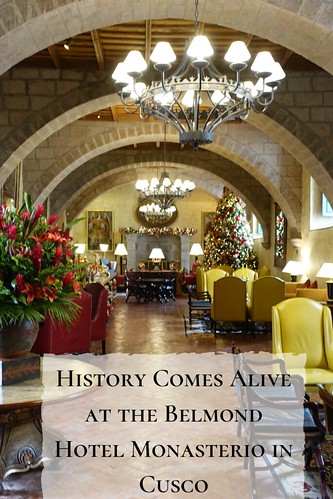
The National Institute of Culture designated the property as a national landmark, and the property is now part of the exclusive collection of Belmond’s luxury hotels.
After trekking through Machu Picchu, we boarded the luxurious Belmond Hiram Bingham train from Machu Picchu to Cusco, a UNESCO World Heritage Site. By the time we disembarked the train, took a short bus ride, and then entered the cavernous Belmond Hotel Monasterio lobby with stone archways and oversized wooden doors, Ira and I were half asleep from our full day of adventure. We quickly reawakened, as modern chandeliers illuminated a room that took us back to a time when the Spaniards colonized the Americas.
Inside a Dining Car of the Belmond Hiram Bingham
Modern Accommodations Reflecting an Earlier Time
A hotel employee escorted us up a wide stone staircase; well-worn steps led to a narrow hallway. He slid an oversized key into the simple lock to open our wooden door. The queen size bed consumed most of the available area.

Hotel Monasterio Guest Room
Keeping in mind that Jesuits didn’t require much space while living an austere lifestyle, it’s not surprising that our guestroom appeared small. The pint-sized modern marble appointed bathroom with a shower was apportioned to the room. Antique furniture and religious artwork carried through the theme of the hotel–a mixture of 16th-century Spanish architecture and modern luxury. Our shutters blocked all daylight, and offered complete privacy.
While none of the 122 rooms and suites is alike, each room is designed to reflect the building’s original culture. Since we were part of a small group tour arranged in conjunction with a Galapagos Island Celebrity Xpedition cruise, we didn’t have the opportunity to select our room. If traveling independently, it is advisable to review the hotel’s website to better understand the tiered room options.
History Reverberates Throughout the Hotel
Time did not permit a guided tour of the historical elements. We gladly took the initiative to peruse the common areas. To avoid an afternoon storm, we admired the central courtyard from the second-floor hallways. A series of open arches around the perimeter of the ample rectangular space offered non-stop opportunities to admire an oversized 300-year-old cedar tree surrounded by manicured gardens dotted with a handful of tables with umbrellas. The deserted tables and chairs filled up quickly after the storm clouds departed.
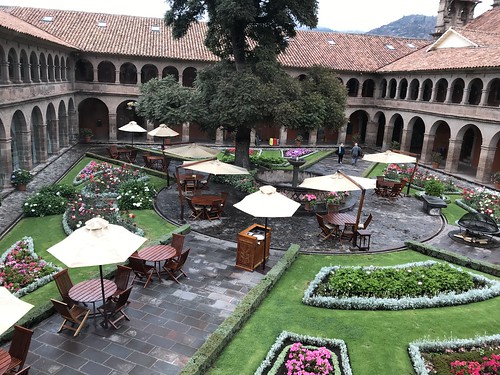
Belmond Hotel Monasterio Main Courtyard
The hallways adjacent to the courtyard resembled an art museum filled with paintings dating back hundreds of years. Most had an identifying plaque. The hotel boasts that it has the best collection of 18th-century colonial religious art in Cusco. Daniel, one of the hotel’s receptionists, informed us that the original works of art were in the chapel, the restaurants, and on the second floor.

Belmond Monasterio Hotel Painting in Guestroom
After unsuccessful attempts to locate an original Diego Quispe Tito (1611-1681) painting, Daniel assisted us. As it turned out, this famous piece of art was partially blocked by a Christmas tree. Our earlier tour of Cusco had given us a crash course on the Cuzqueño School (Cusco School), so we were somewhat familiar with this artist’s notable work since he is considered the leader of the Cusco School of painting. European artists who arrived in Cusco during the Spanish colonization introduced the local painters to European art. Tito is known for his ability to incorporate Italian Mannerism and Flemish painting into his landscape paintings filled with birds and angels.
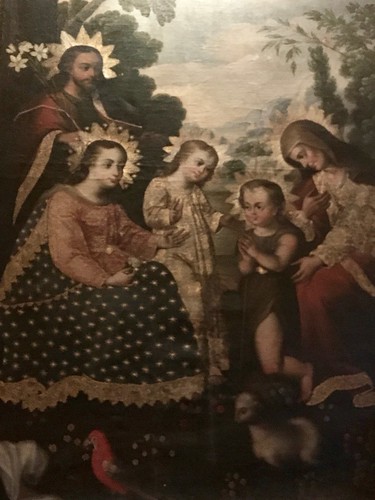
Belmond Hotel Monasterio PaintingTitled The Sacred Family Mesitzo Synthesis; Diego Quisepe Tito School late 17th century
We wandered into the San Antonio de Abad Chapel, a baroque-styled chapel built after the mid-17th-century earthquake. As our eyes adjusted to the dimmer light, we viewed the many oversized religious paintings hanging on the walls. This opulent chapel was a mini-version of the more famous landmarks a few blocks away.
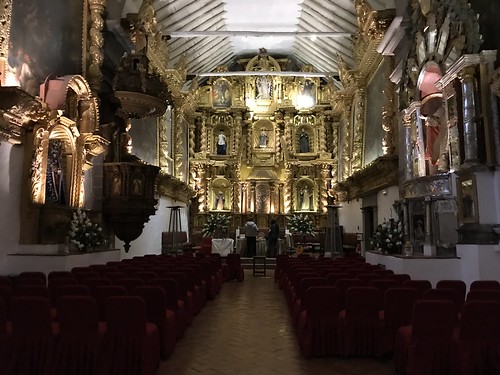
San Antonio de Abad Chapel
Breakfast Buffet in the Illariy Dining Room
The Illariy dining room was just as impressive as the lobby. Oversized arches separated each section of the main hall, and a narrow corridor with more tables straddled the archways, offering excellent views of the garden courtyard.
A sizeable breakfast buffet was set out on several tables each morning. Entrees appealed to Peruvian and international guests. A small menu with cooked items—eggs, omelets, pancakes, and French toast—could also be ordered at our table. As we tried an assortment of Peruvian foods that in some respects resembled Mediterranean cuisine, a guitarist played in the background. Luckily, I had the foresight to carry a sweater to offset the morning’s chilly temperature at this high altitude destination.
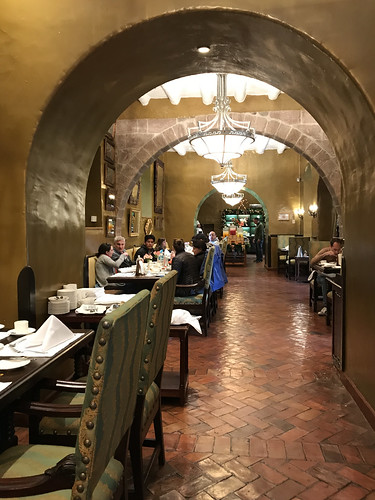
Belmond Hotel Monasterio Archways in Breakfast Dining Room
3-Course Peruvian Fusion Dinner at the El Tupay Restaurant
As we looked over our tour’s special menu, a pair of opera singers worked in tandem. Three times a week, they performed during a special opera dinner. Our waiter let us know that the chef locally sourced the menu’s ingredients. A few selections were labeled as gluten-free and vegetarian.
We happily shared two starters—the chef’s salad with smoked trout, mango, radish, fennel bulbs, and cape gooseberries topped with mango vinaigrette, and three grilled shrimp arranged on a quinoa tabbouleh with roasted yellow chili and citrus foam.
For dinner, I enjoyed one of the restaurant’s specialties— the Pacific fish prepared with a polenta puree with candied tomatoes, olives, grilled asparagus, and pesto made from Andean herbs. After back-to-back days of eating local fish, Ira selected quinoa ravioli stuffed with pumpkin. A Parma Rosa sauce, grated cheese, and spices rounded out the flavors of this homemade pasta. Just about every meal in Peru included a new way to use quinoa. I can’t recall ever eating ravioli made with quinoa flour.
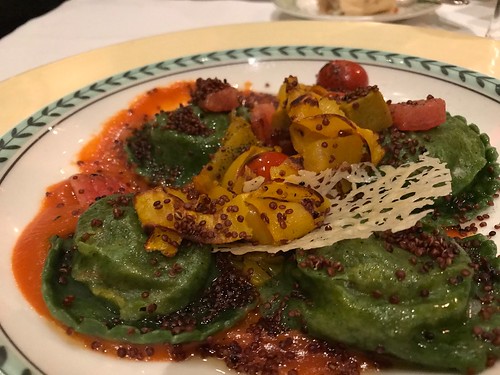
Quinoa Ravioli at El Tupay Restaurant
Our waiter showed us two dessert options; a thinly layered chocolate creation garnished with raspberry sauce and homemade chocolate ice cream was our unanimous choice.

Dessert at El Tupay Restaurant
Central Location
The hotel is within walking distance of many of the popular attractions—Plaza de Armas, La Catedral, Campana de Jesus, Monasterio de Santa Catalina, and Museo Machu Picchu, as well as others. Many visitors select Cusco as the place to launch their tours to the Sacred Valley and Machu Picchu.
Two Helpful Tips
• People with health concerns, including those requiring the use of a CPAP machine, should be aware that the city sits over 11,000 feet above sea level. Appropriate precautions need to be taken before ascending to this elevation.
• Individuals interested in a once in a lifetime experience aboard the Belmond Hiram Bingham train should reserve their spot before arriving in Peru.
Going Back in Time
Walking through the hallways and up and down rigid staircases, as well as sleeping in our miniscule guestroom, allowed us to imagine a small slice of the Spanish missionaries’ lifestyle. Cusco, the oldest continuously inhabited city in the Americas, was the capital of the Inca Empire before the Spanish Conquistadors arrived. In the former monastery, we caught a glimpse of life centuries ago and were able to appreciate how history comes alive in the Hotel Belmond Monasterio.
Sandy Bornstein, the History Comes Alive Through Travel Editor for Wandering Educators, has visited more than 40 countries and lived as an international teacher in Bangalore, India. Sandy’s award-winning book, May This Be the Best Year of Your Life, is a resource for people contemplating an expat lifestyle and living outside their comfort zone. Sandy writes about Jewish culture and history, historical sites, family, intergenerational, and active midlife adventures highlighting land and water experiences.
All photos courtesy and copyright Sandy Bornstein


















